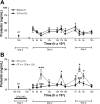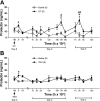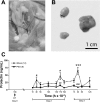Systemic oxytocin induces a prolactin secretory rhythm via the pelvic nerve in ovariectomized rats
- PMID: 21677274
- PMCID: PMC3174764
- DOI: 10.1152/ajpregu.00176.2011
Systemic oxytocin induces a prolactin secretory rhythm via the pelvic nerve in ovariectomized rats
Abstract
We have shown previously that an intravenous injection of oxytocin (OT) in ovariectomized (OVX) rats initiates a circadian rhythm of prolactin (PRL) secretion similar to that observed after cervical stimulation (CS). In this study, we investigated the pathway through which OT triggers the PRL rhythm. We first tested whether an intracerebroventricular injection of OT could trigger the PRL secretory rhythm. As it did not, we injected OT intravenously while an OT receptor antagonist was infused intravenously. This antagonist completely abolished the PRL surges, suggesting that a peripheral target of OT is necessary for triggering the PRL rhythm. We hypothesized that OT may induce PRL release, which would be transported into the brain and trigger the rhythm. In agreement with this, OT injection increased circulating PRL by 5 min. To test whether this acute increase in PRL release would induce the PRL rhythm, we compared the effect of intravenously administered thyrotropin-releasing hormone (TRH) and OT. Although TRH injection also increased PRL to a comparable level after 5 min, only OT-injected animals expressed the PRL secretory rhythm. Motivated by prior findings that bilateral resection of the pelvic nerve blocks CS-induced pseudopregnancy and OT-induced facilitation of lordosis, we then hypothesized that the OT signal may be transmitted through the pelvic nerve. In fact, OT injection failed to induce a PRL secretory rhythm in pelvic-neurectomized animals, suggesting that the integrity of the pelvic nerve is necessary for the systemic OT induction of the PRL secretory rhythm in OVX rats.
Figures



Comment in
-
Peripheral regulation of prolactin by oxytocin: focus on "Systemic oxytocin induces a prolactin secretory rhythm via the pelvic nerve in ovariectomized rats".Am J Physiol Regul Integr Comp Physiol. 2011 Sep;301(3):R674-5. doi: 10.1152/ajpregu.00331.2011. Epub 2011 Jun 29. Am J Physiol Regul Integr Comp Physiol. 2011. PMID: 21715700 No abstract available.
References
-
- Arletti R, Bertolini A. Oxytocin stimulates lordosis behavior in female rats. Neuropeptides 6: 247–253, 1985 - PubMed
-
- Beach JE, Tyrey L, Everett JW. Prolactin secretion preceding delayed pseudopregnancy in rats after electrical stimulation of the hypothalamus. Endocrinology 103: 2247–2251, 1978 - PubMed
-
- Ben-Jonathan N, Hnasko R. Dopamine as a prolactin (PRL) inhibitor. Endocr Rev 22: 724–763, 2001 - PubMed
-
- Berkley KJ, Robbins A, Sato Y. Functional differences between afferent fibers in the hypogastric and pelvic nerves innervating female reproductive organs in the rat. J Neurophysiol 69: 533–544, 1993 - PubMed
Publication types
MeSH terms
Substances
Grants and funding
LinkOut - more resources
Full Text Sources
Research Materials

